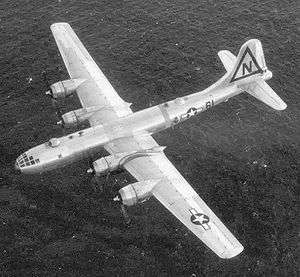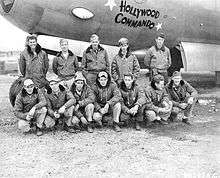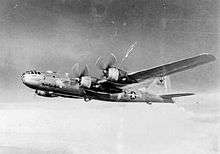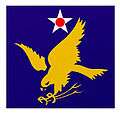677th Bombardment Squadron
The 677th Bombardment Squadron is a former United States Army Air Forces unit. It was last assigned to the 444th Bombardment Group at Davis-Monthan Field, Arizona.
| 677th Bombardment Squadron | |
|---|---|
 677th Squadron B-29 Superfortress[note 1] | |
| Active | 1943-1946 |
| Country | |
| Branch | |
| Role | heavy bomber |
| Engagements | American Theater of World War II China Burma India Theater Pacific Theater of Operations |
| Decorations | Distinguished Unit Citation |
| Insignia | |
| 677th Bombardment Squadron Emblem (approved 31 October 1946)[1] |  |
During World War II, the squadron was an Army Air Forces combat organization. It was part of the first Boeing B-29 Superfortress group formed for the 58th Bombardment Wing, and served in the China Burma India Theater and Pacific Ocean Theater as part of Twentieth Air Force. The squadron's aircraft engaged in very heavy bombardment operations against Japan. The squadron received the Distinguished Unit Citation for its combat operations on three occasions. When the unit was inactivated on 1 October 1946 its B-29 aircraft and personnel were reassigned to the 43d Bombardment Group.
History
Training for combat
The squadron was first activated as the 677th Bombardment Squadron on 1 March 1943 at Davis-Monthan Field, Arizona, one of the original squadrons of the 444th Bombardment Group.[1] The 444th was assigned to the first Boeing B-29 Superfortress wing, the 58th Bombardment Wing. After a period of organization at Davis-Monthan the squadron moved to Great Bend Army Air Field, Kansas. for training, initially flying Boeing B-17 Flying Fortresses, Consolidated B-24 Liberators and Martin B-26 Marauders.[2] The group engaged in training on the new aircraft and its mission of long range precision bombing. At Great Bend, the squadron received early model B-29s and prototype YB-29s, however aircraft were still undergoing development and were frequently modified by Boeing technicians in the field while the squadron was undergoing training in Kansas. In November 1943 The 444th reorganized as a Very Heavy group and added the 6th Bombardment Maintenance Squadron, which was paired with the 677th to maintain its B-29s.[3]

China Burma India Theater

In early April 1944, the squadron left the United States and deployed to a former B-24 Liberator airfield at Charra Airfield, India. The first airplane of the 444th group landed at Charra on 11 April 1944. Due to the lack of revetments at Charra the squadron's airplanes were parked wingtip to wingtip on the field's shorter runway. Charra served only as a maintenance and staging base. Its runways were too short for a B-29 to take off fully loaded. While the squadron was stationed there, all missions were flown from the bases of the other bombardment groups of the 58th Bombardment Wing.[4]
From India, the 677th planned to fly missions against Japan from advanced airfields in China. However, all the supplies of fuel, bombs and spare parts needed to support operations from the forward bases in China had to be flown from India over The Hump. For this role, one aircraft from the squadron was stripped of combat equipment and used as a flying tanker. Each aircraft carried seven tons of fuel, but the amount that was delivered to China depended on weather, including headwinds and aircraft icing which increased the fuel consumption of the "tankers."[5]
The squadron flew its first combat mission on 5 June 1944 against the Makasan railroad yards at Bangkok, Thailand. Ten days later the 677th participated in the first American air attack on the Japanese home islands since the 1942 Doolittle raid, staging through Chinese bases on a nighttime raid against the iron and steel works at Yawata, Japan.[6] It returned to Yawata on 20 August on a daytime raid for which the unit was awarded the Distinguished Unit Citation.[1] Operating from bases in India and at times staging through fields in China, the group struck transportation centers, naval installations, aircraft plants and other targets in Burma, China, Thailand, Japan and Formosa.[2]
On 12 October 1944 the group reorganized. The 679th Bombardment Squadron and the four bombardment maintenance squadrons were disbanded and their personnel and equipment were transferred to 677th and the other squadrons of the group.[1][3] As the new year started, Japanese advances forced withdrawal from the Chinese forward operating bases. Unable to continue attacks on Japan, the unit continued attacking targets in Southeast Asia.[2]
Pacific Theater
In the spring of 1945 the 444th and the other groups of the 58th wing moved to Tinian in the Marianas in order to continue operations against Japan. The group and squadron participated in the bombing of strategic objectives, strategic mining of the Inland Sea and in incendiary attacks on urban areas for the duration of the war. The 677th received a second Distinguished Unit Citation for attacking oil storage facilities at Oshima, bombing an aircraft plant near Kobe, and dropping incendiaries on Nagoya in May 1945. The squadron struck light metal industries at Osaka in July 1945, receiving a third Distinguished Unit Citation for this action.[2] The squadrons's final mission was flown against Hikari, Japan on 14 August 1945, the day before the Japanese surrender.[7]
Strategic Air Command
The 677th returned to the United States and Merced Army Air Field, California in November 1945 where it became part of Fourth Air Force of Continental Air Forces (CAF). CAF became Strategic Air Command (SAC) in March 1946 and the 676th was one of the first bombardment units assigned to SAC. In May the squadron moved back to Davis-Monthan Field, where it was integrated with the host 248th AAF Base Unit.[8] The 677th inactivated on 1 October 1946[1] and its personnel and aircraft were reassigned to units of the 43d Bombardment Group,[9][10] which was activated at Davis-Monthan on that day as part of the re-established Eighth Air Force.[11]
Lineage
- Constituted as the 677th Bombardment Squadron (Heavy) on 15 February 1943
- Activated on 1 March 1943
- Redesignated 677th Bombardment Squadron (Heavy) (B-29) on 26 April 1943
- Redesignated 677th Bombardment Squadron (Very Heavy) on 20 November 1943
- Inactivated on 1 October 1946[12]
Assignments
- 444th Bombardment Group: 1 March 1943 - 1 October 1946
Stations
|
|
Aircraft
|
|
Awards and Campaigns
| Award streamer | Award | Dates | Notes |
|---|---|---|---|
| Distinguished Unit Citation | 20 August 1944 | Yawata, Japan[1] | |
| Distinguished Unit Citation | 10 to 14 May 1945 | Japan[1] | |
| Distinguished Unit Citation | 24 July 1945 | Osaka, Japan[1] |
| Campaign Streamer | Campaign | Dates | Notes |
|---|---|---|---|
| American Theater of World War II without inscription | 1 March 1943-12 March 1944 | [1] | |
| India-Burma | 13 April 1944–April 1945 | [1] | |
| Central Burma | 29 January 1945–April 1945 | [1] | |
| Air Offensive, Japan | 13 April 1944–2 September 1945 | [1] | |
| China Defensive | 13 April 1944–4 May 1945 | [1] | |
| Western Pacific | 17 April 1945–2 September 1945 | [1] |
See also
References
Notes
- Explanatory notes
- Aircraft is Boeing B-29, serial 42-63411, "Dutchess", showing Triangle N tail marking used on Tinian.
- Citations
- Maurer, Combat Squadrons, pp. 703–704
- Maurer, Combat Unitspp. 318–319
- "Abstract, History 5th Bombardment Maintenance Squadron". Air Force History Index. Retrieved August 28, 2013.
- Pictorial History, pp. 32–33
- Pictorial History, p. 85
- Pictorial History, p. 86
- Pictorial History, p. 128
- "Abstract, Vol. I History of Davis-Monthan Field May 1946". Air Force History Index. Retrieved August 28, 2013.
- "Abstract, History Davis-Monthan Field October-November 1946". Air Force History Index. Retrieved August 28, 2013.
- Pictorial History, p. 164
- Maurer, Combat Units, p. 100
- Lineage, assignments, stations, aircraft, awards and campaigns in Maurer, Combat Squadrons, pp. 703-704, except April 1943 redesignation, see Robertson, Patsy (April 6, 2010). "Factsheet 444 Air Expeditionary Wing (ACC)". Air Force Historical Research Agency. Archived from the original on January 7, 2016. Retrieved December 18, 2019.
Bibliography
![]()
- Maurer, Maurer, ed. (1983) [1961]. Air Force Combat Units of World War II (PDF) (reprint ed.). Washington, DC: Office of Air Force History. ISBN 0-912799-02-1. LCCN 61060979.
- Maurer, Maurer, ed. (1982) [1969]. Combat Squadrons of the Air Force, World War II (PDF) (reprint ed.). Washington, DC: Office of Air Force History. ISBN 0-405-12194-6. LCCN 70605402. OCLC 72556.
- Unknown (1945). The Pictorial History of the 444th Bombardment Group, Very Heavy, Special. Bangor Public Library World War Regimental Histories No. 128. San Angelo, TX: Newsfoto Publishing Co. Retrieved August 27, 2013. No page numbers in book. Page numbers are from online .pdf
.png)
